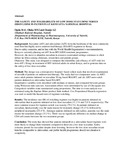The Safety And Tolerability Of Low Dose Stavudine Versus Zidovudine In Patients At Kenyatta National Hospital

View/
Date
2013-06Author
Ogola, BA
Oluka, MN
Osanjo, G
Type
PresentationLanguage
enMetadata
Show full item recordAbstract
Background: Stavudine (d4T) and zidovudine (AZT) form the backbone of the
most commonly used first-line highly active antiretroviral therapy (HAART)
regimens in Kenya.
Due to safety concerns, and in line with the World Health Organization’s
recommendation, Kenya is currently phasing out d4T from HIV/AIDS treatment
programmes.
However, the move to abandon stavudine in resource constrained settings continues
to elicit debate in Africa among clinicians, researchers and patient groups.
Objective: This study was designed to compare the tolerability and efficacy of AZT
with low dose d4T (30 mg) in treatment of HIV infected adults in urban Kenya, and
to generate data on the safety of low dose stavudine.
Method: The design was a retrospective hospital- based cohort study that involved
examination of records of patients on antiretroviral therapy. The study had two
comparator arms: (i) ART-naive adult patients initiated on stavudine 30 mg based
HAART, and (ii) ART-naive adult patients initiated on zidovudine based HAART.
Quantitative variables were described with medians or means, and compared between
groups using Wilcoxon rank sum test. Association effects were determined by use
of Chi-square test. Categorical variables were summarized using proportions. The
time to event analysis was estimated using the Kaplan–Meier product limit method.
Cox Proportional Hazards regression was used to model the hazard rates of regimen
switching.
Results: The incidence rate (IR) of switching regimen was higher in patients initiated
on zidovudine than in patients initiated on low dose stavudine (11.3 % and 7.0 %
respectively). The most common reason for regimen switch was toxicity (79.2 %).
In patients initiated on stavudine, lipodystrophy was the main reason for treatment
change (53.2 %) followed by peripheral neuropathy (23.4 %). Amongst patients
initiated on zidovudine, anaemia was the main reason for treatment change (33.3 %).
There was no significant difference in median change in CD4 cell counts between the
two treatment groups.
Conclusion: The study has showed that patients initiated on a zidovudine based
regimen were more likely to change their treatment compared to those on a low dose
stavudine. Safety concerns persist for stavudine despite dose lowering, however
the low dose stavudine retain benefits comparable to zidovudine, and public health
programmes should not abandon it completely.
Citation
Ogola, B.A.,Oluka, M.N.,Osanjo, G.,The Safety And Tolerability Of Low Dose Stavudine Versus Zidovudine In Patients At Kenyatta National Hospital,presented at the 2nd International Scientific Conference, CHS And KNH, 19th - 21st June 2013.Publisher
University of Nairobi
Description
The Safety And Tolerability Of Low Dose Stavudine Versus Zidovudine In Patients At Kenyatta National Hospital,presented at the 2nd International Scientific Conference, CHS And KNH, 19th - 21st June 2013.
